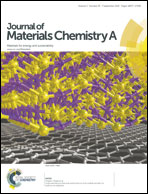Ti-substituted Li[Li0.26Mn0.6−xTixNi0.07Co0.07]O2 layered cathode material with improved structural stability and suppressed voltage fading†
Abstract
Despite considerable effort, practical application of high-energy-density, lithium (Li)- and manganese (Mn)-rich layered cathode materials remains difficult due to the low first cycle efficiency, poor structural stability, and the consequent voltage fading. In the present work, the Li- and Mn-rich layered cathodes of Li[Li0.26Mn0.6−xTixNi0.07Co0.07]O2 (0 < x < 0.1) with various titanium (Ti) compositions were synthesized and their electrochemical properties were evaluated. It was found that Ti substitution greatly improves the structural stability of the Li- and Mn-rich layered cathode materials, extending the cathode’s cycle life and mitigating the voltage fading. The present first-principles analyses of the cohesive energy, phonon force constants, and charge density of these materials indicate that Ti substitution increases the stability of the layered structure and prevents Mn ions migration from transitional metal layer to adjacent Li-ion layer. These theoretical analyses coincide with the present experimental results and provide the underlying mechanism behind the improved cycling stability and weakened voltage fading.
![Graphical abstract: Ti-substituted Li[Li0.26Mn0.6−xTixNi0.07Co0.07]O2 layered cathode material with improved structural stability and suppressed voltage fading](/en/Image/Get?imageInfo.ImageType=GA&imageInfo.ImageIdentifier.ManuscriptID=C5TA03764F&imageInfo.ImageIdentifier.Year=2015)

 Please wait while we load your content...
Please wait while we load your content...